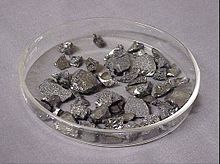Boron
Ang boro (Ingles: boron) ay isang elementong kimikal sa talahanayang peryodiko na sinasagisag ng simbolong B at nagtataglay ng atomikong bilang 5.
 boron (β-rhombohedral)[1] | ||||||||||||||||||||||||||
| Boron | ||||||||||||||||||||||||||
|---|---|---|---|---|---|---|---|---|---|---|---|---|---|---|---|---|---|---|---|---|---|---|---|---|---|---|
| Pronunciation | /ˈbɔːrɒn/ | |||||||||||||||||||||||||
| Allotropes | α-, β-rhombohedral, β-tetragonal (at marami pa) | |||||||||||||||||||||||||
| Appearance | black-brown | |||||||||||||||||||||||||
| Standard atomic weight Ar°(B) | ||||||||||||||||||||||||||
| Boron in the periodic table | ||||||||||||||||||||||||||
| ||||||||||||||||||||||||||
| Atomic number (Z) | 5 | |||||||||||||||||||||||||
| Group | 13 | |||||||||||||||||||||||||
| Period | 2 | |||||||||||||||||||||||||
| Block | p-block | |||||||||||||||||||||||||
| Electron configuration | [He] 2s2 2p1 | |||||||||||||||||||||||||
| Electrons per shell | 2, 3 | |||||||||||||||||||||||||
| Physical properties | ||||||||||||||||||||||||||
| Phase at STP | solido | |||||||||||||||||||||||||
| Melting point | 2349 K (2076 °C, 3769 °F) | |||||||||||||||||||||||||
| Boiling point | 4200 K (3927 °C, 7101 °F) | |||||||||||||||||||||||||
| Density when liquid (at m.p.) | 2.08 g/cm3 | |||||||||||||||||||||||||
| Heat of fusion | 50.2 kJ/mol | |||||||||||||||||||||||||
| Heat of vaporization | 508 kJ/mol | |||||||||||||||||||||||||
| Molar heat capacity | 11.087 J/(mol·K) | |||||||||||||||||||||||||
Vapor pressure
| ||||||||||||||||||||||||||
| Atomic properties | ||||||||||||||||||||||||||
| Oxidation states | −5, −1, 0,[4] +1, +2, +3[5][6] (isang katamtamang asidikong oksido) | |||||||||||||||||||||||||
| Electronegativity | Pauling scale: 2.04 | |||||||||||||||||||||||||
| Ionization energies |
| |||||||||||||||||||||||||
| Atomic radius | empirical: 90 pm | |||||||||||||||||||||||||
| Covalent radius | 84±3 pm | |||||||||||||||||||||||||
| Van der Waals radius | 192 pm | |||||||||||||||||||||||||
| Other properties | ||||||||||||||||||||||||||
| Natural occurrence | primordiyal | |||||||||||||||||||||||||
| Crystal structure | rhombohedral | |||||||||||||||||||||||||
| Thermal expansion | β form: 5–7 µm/(m⋅K) (at 25 °C)[7] | |||||||||||||||||||||||||
| Thermal conductivity | 27.4 W/(m⋅K) | |||||||||||||||||||||||||
| Electrical resistivity | ~106 Ω⋅m (at 20 °C) | |||||||||||||||||||||||||
| Magnetic ordering | diamagnetic[8] | |||||||||||||||||||||||||
| Molar magnetic susceptibility | −6.7×10−6 cm3/mol[8] | |||||||||||||||||||||||||
| Speed of sound thin rod | 16,200 m/s (at 20 °C) | |||||||||||||||||||||||||
| Mohs hardness | ~9.5 | |||||||||||||||||||||||||
| CAS Number | 7440-42-8 | |||||||||||||||||||||||||
| History | ||||||||||||||||||||||||||
| Discovery | Joseph Louis Gay-Lussac and Louis Jacques Thénard[9] (30 June 1808) | |||||||||||||||||||||||||
| First isolation | Humphry Davy[10] (9 July 1808) | |||||||||||||||||||||||||
| Isotopes of boron | ||||||||||||||||||||||||||
| ||||||||||||||||||||||||||
May atomikong bigat na 10.118, punto ng pagkatunaw na 2,300oC, nagkakaroon ng sublimasyon sa 2,550oC, may espesipikong grabidad na 2.34 (anyong kristalina), at balensiyang 3) ay isang hindi metalikong elemento na malambot at kakulay ng kape, at nasa anyong amorpus o kristalina. Nakukuha ang mga ito mula sa kerito at boraks. Naihiwalay ito nina Humphry Davy, Joseph Louis Gay-Lussac at Louis Jacques Thénard[11] noong 1808 sa pamamagitan ng reaksiyon ng asidong boriko at ng potasyo. Tinawag ito ni Davy bilang boracium.[12] Nagagamit ang elementong ito para sa paggawa ng mga pampasibad na kemikal, sa mga pampailaw, panggasgas, at maging para sa aloy na matitigas.[11]
Mga sanggunian
baguhin- ↑ Van Setten et al. 2007, pp. 2460–1
- ↑ "Standard Atomic Weights: Boron" (sa wikang Ingles). CIAAW. 2009.
{{cite web}}: CS1 maint: date auto-translated (link) - ↑ Prohaska, Thomas; Irrgeher, Johanna; Benefield, Jacqueline; Böhlke, John K.; Chesson, Lesley A.; Coplen, Tyler B.; Ding, Tiping; Dunn, Philip J. H.; Gröning, Manfred; Holden, Norman E.; Meijer, Harro A. J. (2022-05-04). "Standard atomic weights of the elements 2021 (IUPAC Technical Report)". Pure and Applied Chemistry (sa wikang Ingles). doi:10.1515/pac-2019-0603. ISSN 1365-3075.
{{cite journal}}: CS1 maint: date auto-translated (link) - ↑ Braunschweig, H.; Dewhurst, R. D.; Hammond, K.; Mies, J.; Radacki, K.; Vargas, A. (2012). "Ambient-Temperature Isolation of a Compound with a Boron-Boron Triple Bond". Science (sa wikang Ingles). 336 (6087): 1420–2. Bibcode:2012Sci...336.1420B. doi:10.1126/science.1221138. PMID 22700924. S2CID 206540959.
{{cite journal}}: CS1 maint: date auto-translated (link) - ↑ Zhang, K.Q.; Guo, B.; Braun, V.; Dulick, M.; Bernath, P.F. (1995). "Infrared Emission Spectroscopy of BF and AIF" (PDF). J. Molecular Spectroscopy (sa wikang Ingles). 170 (1): 82. Bibcode:1995JMoSp.170...82Z. doi:10.1006/jmsp.1995.1058.
{{cite journal}}: CS1 maint: date auto-translated (link) - ↑ Melanie Schroeder. Eigenschaften von borreichen Boriden und Scandium-Aluminium-Oxid-Carbiden (PDF) (sa wikang Ingles). p. 139.
- ↑ Holcombe Jr., C. E.; Smith, D. D.; Lorc, J. D.; Duerlesen, W. K.; Carpenter; D. A. (Oktubre 1973). "Physical-Chemical Properties of beta-Rhombohedral Boron". High Temp. Sci. 5 (5): 349–57.
{{cite journal}}: CS1 maint: date auto-translated (link) - ↑ 8.0 8.1 Haynes, William M., pat. (2016). CRC Handbook of Chemistry and Physics (ika-97th (na) edisyon). CRC Press. p. 4.127. ISBN 9781498754293.
{{cite book}}: CS1 maint: date auto-translated (link) - ↑ Gay Lussac, J.L.; Thenard, L.J. (1808). "Sur la décomposition et la recomposition de l'acide boracique". Annales de chimie. 68: 169–174.
{{cite journal}}: CS1 maint: date auto-translated (link) - ↑ Davy H (1809). "An account of some new analytical researches on the nature of certain bodies, particularly the alkalies, phosphorus, sulphur, carbonaceous matter, and the acids hitherto undecomposed: with some general observations on chemical theory". Philosophical Transactions of the Royal Society of London. 99: 39–104. doi:10.1098/rstl.1809.0005.
{{cite journal}}: CS1 maint: date auto-translated (link) - ↑ 11.0 11.1 Gaboy, Luciano L. Boron - Gabby's Dictionary: Praktikal na Talahuluganang Ingles-Filipino ni Gabby/Gabby's Practical English-Filipino Dictionary, GabbyDictionary.com.
- ↑ Weeks, Mary Elvira (1933). "XII. Other Elements Isolated with the Aid of Potassium and Sodium: Beryllium, Boron, Silicon and Aluminum". The Discovery of the Elements. Easton, PA: Journal of Chemical Education. ISBN 0-7661-3872-0.
{{cite book}}: CS1 maint: date auto-translated (link)

